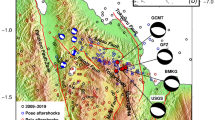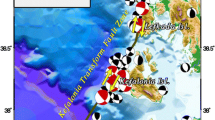Abstract
More than 1000 aftershocks were recorded within a month after the occurrence of the ML 5.5, 5 August 2014 Orkney earthquake. The events were relocated using the double difference method as part of an effort to identify the fault which might be the source of the events. A north–south trend of seismicity was revealed by the relocated events, with a diffuse cluster to the north of the main event. A depth profile shows these two clusters: one at a depth of about 2 km to the north of the main event and the other at depth between 3 and 6 km south of the main event. Focal mechanism solutions of 18 aftershocks were determined using first motion polarities from seismic stations of the Council for Geoscience cluster networks. Stress inversion analysis results from the focal mechanism solutions show a dominant extensional stress field in the region; the main event had a strike-slip fault plane solution. This is consistent with the regional stress field which is predominantly related to the East African rift system. It is possible that the occurrence of the main event triggered seismicity on shallower faults within the mining horizons oriented in a different direction to the fault on which the main event occurred. The area has a complex heterogeneous faulting structure as indicated by the observed low p values and complex focal mechanism solutions.









Similar content being viewed by others
References
Angelier J, Mechler P (1977) Sur une méthode graphique de recherche des contraintes principales également utilisable en tectonique et en séismologie: la méthode des dièdres droits. Bulletin de la société géologique de France 19:1309–1318
Arabasz WJ, Pechmann JC (2001) Seismic characterisation of coal-mining seismicity in Utah for CTBT monitoring. Technical Report UCRL-CR-143772, Lawrence Livermore National Laboratory, Livermore, California, LLNL Research Agreement No. B344836; http://www.quake.utah.edu/Reports/llnl2001/index.shtml, 120 pps
Bennett TJ, Marshall ME, Mclaughlin KL, Barker BW, Murphy JR (1996) Seismic characteristics and mechanisms of rockbursts. In Proceedings of the 18th Annual Seismic Research Symposium on Monitoring a Comprehensive Test Ban Treaty Phillips Laboratory, 153: 901–907
Calais E, Camelbeeck T, Stein S, Liu M, Craig TJ (2016) A new paradigm for large earthquakes in stable continental plate interiors. Geophys Res Lett 43. doi:10.1002/2016GL070815
Cichowicz A (2015) Routine estimation of source parameters of mining-related earthquakes: including the initial analysis of the earthquake of magnitude 5.5, South African, deep gold mine. Proceedings of the 10th AfricaArray Workshop 18–26 January 2015, Johannesburg, South Africa
Cichowicz A, Kometsi R, Birch D, van Aswegen G, Kgaswane E, Saunders I, Jele V, Fisha L, Adamos P, Tabane L (2012) Geotechnical investigations—characterisation of near surface ground for CGS cluster networks. CGS Report no: 2012–0023
Delvaux D (1993) The TENSOR program for paleostress reconstruction: examples from the east African and the Baikal rift zones. EUG VII Strasbourg, France, 4–8 April 1993. Abstract supplement N°1 to Terra Nov. 5: 216
Delvaux D, Barth A (2010) African stress pattern from formal inversion of focal mechanism data. Implications for rifting dynamics. Tectonophysics 482:105–128
Delvaux D, Sperner B (2003) Stress tensor inversion from fault kinematic indicators and focal mechanism data: the TENSOR program. In: New Insights into Structural Interpretation and Modelling (D. Nieuwland Ed.). Geological Society, London, Special Publications 212: 75–100
Drakatos G, Latoussakis J (2012) A catalog of aftershock sequences in Greece (1971–1997): their spatial and temporal characteristics. Jounal of Seismology 5:137–145
Durrheim RJ, Anderson RL, Cichowicz A, Ebrahim-Trollope R, Hubert G, Kijko A, McGarr A, Ortlepp WD, van der Merwe, N (2006) The risks to miners, mines, and the public posed by large seismic events in the gold mining districts of South Africa. In Proceedings of the Third International Seminar on Deep and High Stress Mining, 2–4 October 2006, Quebec City, CANADA, J Hadjigeorgiou and M Grenon (editors), Université Laval, Canada
Enescu B, Enescu D, Ito K (2011) Values of b and p: their variations and relation to physical processes for earthquakes in Japan and Romania. Romanian Journal of Physics 56(3–4):590–608
Fonseca JFBD, Chamussa J, Domingues A, Helffrich G, Antunes E, van Aswegen G, Pinto LV, Custódio S, Manhiça VJ (2014) MOZART: a seismological investigation of the east African rift in Central Mozambique. Seismol Res Lett 85(1):108–116
Ford SR, Dreger DS, Walter WR (2008) Source characterisation of the 6 August 2007 Crandall Canyon mine seismic event in Central Utah. Seismol Res Lett 79(5). doi:10.1785/gssrl.79.5.637
Gomberg JS, Shedlock KM, Roecker SW (1990) The effect of S-wave arrival times on the accuracy of hypocenter estimation. Bull Seismol Soc Am 80:1605–1628
Green RWE, Bloch S (1971) The Ceres South Africa earthquake of September 29, 1969: report on some aftershocks. Bull Seismol Soc Am 61(4):851–859
Gutenberg R, Richter CF (1944) Frequency of earthquake in California. Bull Seismol Soc Am 34:158–188
Hartnady CJH (1990) Seismicity and plate boundary evolution in south eastern Africa. S Afr J Geol 93:473–484
Hartnady CJH (1996) Seismotectonic provinces of South Africa: critical review and new proposals. CGS Report no: 1996–0029
Hartnady CJH (2002) Earthquake hazard in Africa: perspectives on the Nubia–Somalia boundary. South African Journal of Science 98
Hauksson E, Jones LM, Hutton K (2002) The 1999 Mw 7.1 Hector mine, California, earthquake sequence: complex conjugate strike-slip faulting. Bull Seismol Soc Am 92(4):1154–1170
Heidbach O, Tingay M, Barth A, Reinecker J, Kurfeß D, Müller B (2010) Global crustal stress pattern based on the World Stress Map database release 2008. Tectonophysics 482:3–15. doi:10.1016/j.tecto.2009.07.023
Johnston AC (1996) Seismic moment assessment of earthquakes in stable continental regions-I. Instrumental seismicity. Geophys J Int 124:381–414
Julià J, Nyblade AA, Durrheim RJ, Linzer L, Gök R, Dirks P, Walter-Source W (2009) Mechanisms of mine-related seismicity, Savuka Mine, South Africa. Bull Seismol Soc Am 99(5):2801–2814. doi:10.1785/0120080334
Kgarume TE (2010) Mine aftershocks and implications for seismic hazard assessment. MSc thesis unpublished, Witwatersrand University
Kisslinger C (1996) Aftershocks and fault zone properties. Adv Geophys 38:1–36
Kisslinger C, Jones LM (1991) Properties of aftershock sequences in southern California. J Geophys Res. doi:10.1029/91JB01200
Leydecker G, Grünthal G, Adorner L (1998) Der Gebirgsschlag vom 13. März 1989 bei Völkershausen in Thüringen im Kalibergbaugebiet des Werratals -- Makroseismische Beobachtungen und Analysen. Geologisches Jahrbuch, Reihe E, 55
Linzer L, Bejaichund M, Cichowicz A, Durrheim RJ, Goldbach OD, Kataka MO, Kijko A, Milev AM, Saunders I, Spottiswoode SM, Webb SJ (2007) Recent research in seismology in South Africa. S Afr J Sci 103(9–10):419–426
Lolli B, Gasperini P (2003) Aftershocks hazard in Italy part I: estimation of time-magnitude distribution model parameters and computation of probabilities of occurrence. J Seismol 7:235–257
Luttrell K, Sandwell D (2010) Ocean loading effects on stress at near shore plate boundary fault systems. Journal of Geophysical Research: Solid Earth 155(B08):411–414
Luttrell K, Sandwell D, Smith-Konter B, Bills B, Bock Y (2007) Modulation of the earthquake cycle at the southern San Andreas fault by lake loading. Journal of Geophysical Research: Solid Earth 112(B08):411–415
Mangongolo A, Kgaswane E (2014) Shear-wave velocity of the upper crust in the Central Rand and Far West Rand mine areas using ambient noise. CGS report 2014–0106
Meghraoui M, Amponsah P, Ayadi A, Ayele A, Ateba B, Bensuleman A, Delvaux D, El Gabry M, Fernandes R, Midzi V, Roos M, Timoulali Y (2016) The seismotectonic map of Africa. Episodes 10(1):9–18. doi:10.18814/epiiugs/2016/v39i1/89232
Midzi V, Zulu B, Manzunzu B, Mulabisana T, Pule T, Myendeki S, Gubela W (2015) Macroseismic survey of the ML 5.5, 2014 Orkney earthquake. J Seismol 19(3):741–751
Mogi K (1962) On the time distribution of aftershocks accompanying the recent major earthquakes in and near Japan. Bulletin of the Earthquake Research Institute 40:107–124
Nuannin P (2006) The potential of b-value variations as earthquake precursors for small and large events; Digital Comprehensive Summaries of Uppsala Dissertations from the Faculty of Science and Technology
Ogata Y (1998) Space-time point-process model for earthquake occurrences. Annals of the Institute of Statistics and Mathematics 50(2):379–402
Ogata Y (1999) Seismicity analysis through point-process modeling: a review. Pure Applied Geophysics 155:471–507
Ottemöller L, Voss P, Havskov J (2013) SEISAN: the earthquake analysis software for Windows, SOLARIS, LINUX and MACKINTOSH Version 9.3. Manual. Department of Earth Science, University of Bergen, Norway
Page R (1968) Aftershocks and micro-earthquakes on the great Alaska earthquake of 1964. Bull Seismol Soc Am 58:1131–1168
Pavlis GL (1986) Appraising earthquake hypocenter location errors: a complete, practical approach for single-event locations. Bull Seismol Soc Am 76:1699–1717
Richardson E, Jordan TH (1999) Seismicity in deep gold mines of South Africa: implications for tectonic earthquakes. Bull Seismol Soc Am 92(5):1766–1782
Snoke JA, Munsey JW, Teague AG, Bollinger GA (1984) A programme for focal mechanism determination by combined use of polarity and SV-P amplitude ratio data. Earthquake Note 55: 15pp
Soumaya A, Ben Ayed N, Delvaux D, Ghanmi M (2015) Spatial variation of present-day stress field and tectonic regime in Tunisia and surroundings from formal inversion of focal mechanisms: geodynamic implications for central Mediterranean. Tectonics 33. doi:10.1002/ 2015TC003895
Utsu T (1957) Magnitude of earthquakes and occurrence of their aftershocks. J Seismol Soc Jpn 10:35–45
Utsu T (1961) A statistical study on the occurrence of aftershocks. Geophys Mag 30:521–605
Utsu T (1962) On the nature of three Alaskan aftershock sequences of 1957 and 1958. Bull Seismol Soc Am 52(2):279–297
Utsu T, Ogata Y, Matsu’ura RS (1995) The centenary of the Omori formula for a decay of aftershock activity. Journal of Physics of the Earth 43:1–33
Uzoegbo H, Li K (2008) Mine-induced seismic events and its effect on nearby settlements in South Africa. The 14th World Conference on Earthquake Engineering October 12–17, 2008, Beijing, China
Waldhauser F, Ellsworth WL (2000) A double-difference earthquake location algorithm: method and application to the Northern Hayward Fault, California. Bull Seismol Soc Am 90(6):1353–1368
Wiemer S (2001) A software package to analyse seismicity: ZMAP. Seismol Res Lett 72:373–382
Acknowledgements
The authors would like to extend their gratitude to the Council for Geoscience for providing seismic data from the national network stations and cluster networks in and around Johannesburg, Carletonville and Klerksdorp. The stress inversion results were obtained using Win-Tensor, a software developed by Dr. Damien Delvaux, Royal Museum for Central Africa, Tervuren, Belgium. The authors are also very grateful for the insightful reviews given by Prof. Mustapha Meghraoui and two other reviewers.
Author information
Authors and Affiliations
Corresponding author
Rights and permissions
About this article
Cite this article
Manzunzu, B., Midzi, V., Mangongolo, A. et al. The aftershock sequence of the 5 August 2014 Orkney earthquake (ML 5.5), South Africa. J Seismol 21, 1323–1334 (2017). https://doi.org/10.1007/s10950-017-9667-z
Received:
Accepted:
Published:
Issue Date:
DOI: https://doi.org/10.1007/s10950-017-9667-z




